This is the start of the tales on pyromania, starting with my father’s tale based on rumours of a burning ship, salvaged furnitures, and a burnt hand and arm. We finally began to unravel the story based on several letters from my parents and additional information from my brother Gavin. To read the full version of the letters, check out SWALK (Interactive version).
The story goes that my father burned his hand trying to rescue the ship’s furniture. At present, this furniture is now safely ensconced in my eldest brother’s (Alexander Whitecross) house in Pittsburgh. There is another rumour that my father set fire to his own boat (‘ship’) for some unknown reason.
To sum up, this whole story was initially based on gossip and rumour. There are the factual details I included here: a photograph of my injured father, a hospital visitor’s card, and letters between my parents. I thought that was all I have about the “Burnt Hand” episode. However, my brother Gavin seems to have finally solved the ‘burnt hand conundrum’. I will also share at the end the emails he sent me in May 2023.
The Photo with Bandaged Hand
The photo of him shown above, after he was discharged from Cowal Hospital Dunoon (sometime around autumn, 1943), shows that he has two stripes. Thus, he was a full lieutenant at the time of the accident. He also has his navy cap vainly cocked at an angle, like a kind of naval Frank Sinatra. I don’t think the burns were that serious as they didn’t leave scars. He was probably in Cowal hospital, Dunoon, for about 3 weeks or a little more.
Another interesting detail in the photo is that he is accompanied by a ‘sergeant’ in civilian clothing. This might be a medical professional employed at Cowal Hospital. In other words, although Cowal Hospital does not seem to have a naval function today (2023), it is not improbable that it had some naval function during the war.
The other question that arises is: Who took the photo? My father’s naval colleagues in Dunoon must have known he was going to be discharged from hospital, and wanted to save this event for posterity!
As mentioned elsewhere here, my father injured his left hand. My father was left-handed, so this may indicate it was an industrial accident of some kind.
The ‘Hospital Pass’
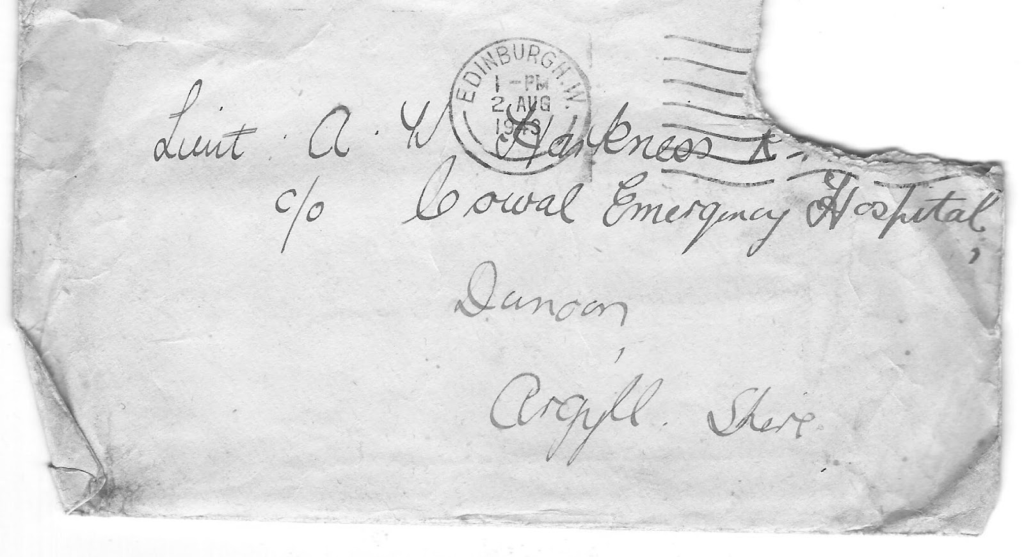
The postal date on the envelope shows 2 August, 1943. The letter is addressed from Edinburgh (2 Chesser Loan). My mother is staying there with my eldest brother, Sandy, who is about 15 months old at the time.

The ‘Hospital Pass’ doesn’t provide much information. The only inference that can be made is that my mother visited my father while he was in the hospital. I think she mentions this in one of her letters, but it is not stated explicitly.
Letters from My Mother
During this period our mother wrote him letters (written from 2 Chesser Loan, Edinburgh). There are four letters that refer to the burnt hand and arm; but, in fact, they say nothing about the injury, or how it happened. Thus, I will only include one of the letters here. But I will also include two other letters relevant to the ‘story’, albeit, indirectly.
However, she seems to be more concerned with ‘domestic’ matters than our father’s injury, and even warns him not to get too ‘frisky’ with the nurses! This also indicates that his injuries were not that serious, but nevertheless had to be treated, possibly to avoid infection or permanent scarring.
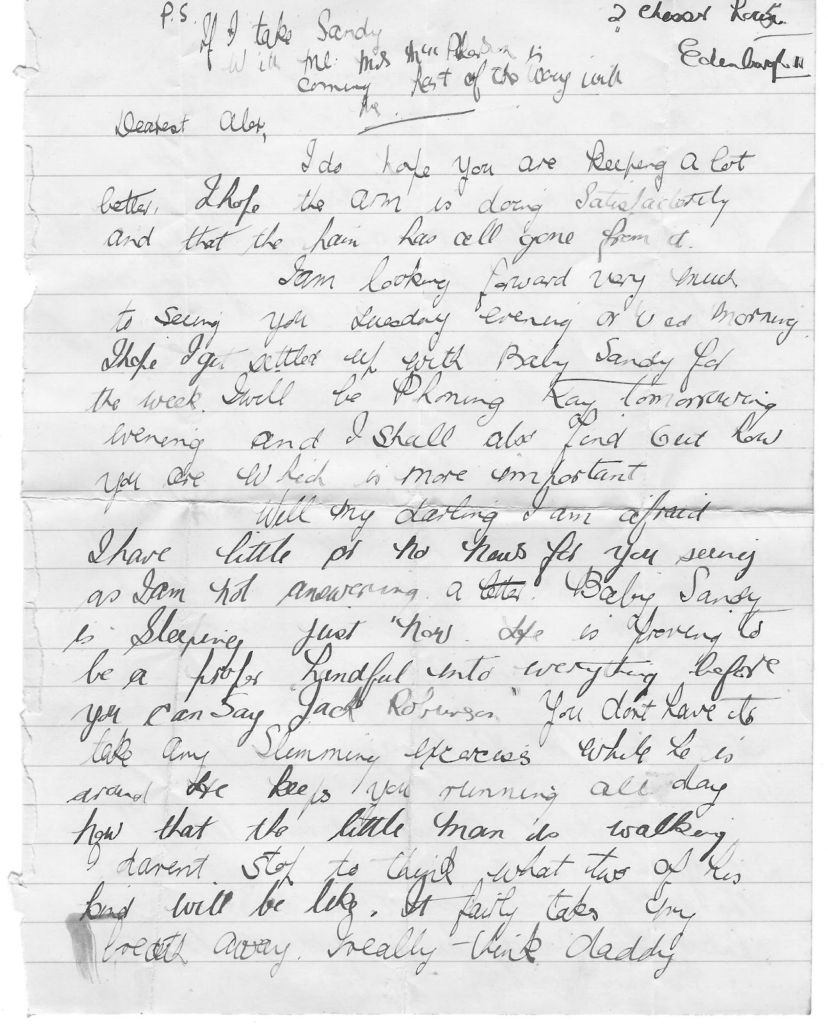

Domestic Woes
Obviously, my father had a ‘serious’ injury or he wouldn’t be in hospital. On the other hand, although my mother expresses concern in the letter, one doesn’t get the impression that the injury is very serious.
She spends most of the letter grumbling about her little ‘naughty’ son Sandy, her pregnancy, and my father’s lack of parenting. The injury gave our father a reprieve from our mother’s ‘nasty’ letters. In other words, our mother was often a real ‘grumbler’ in her letters.
In fact, this may be discussed later; why did my father remain in the navy after the war ended, and travel to Burma? It’s fairly definite that my father had his own ‘Ma Hla May’ in Burma.61
The letter also helps explain the ‘hospital pass’. In the introduction to the letter, my mother expresses concerns for my father’s injury:
“I do hope you are keeping a lot better.”
But, she soon starts to talk about her own domestic problems:
“Baby Sandy is proving to be a proper handful and into everything before you can say ‘Jack Robinson’. (…) Now that the little man is walking.” 62
She then goes on to complain about my father’s lack of involvement in the upbringing of their child.
‘Nasty’ Letters
Some of the letters written by my mother in the year 1943 were so-called ‘nasty’ letters. Understandably, she was raising one young son, with another one on the way. Comically, the three letters written to my father while he was in hospital contain a minimum of ‘nastiness’. We can surmise that my father’s injury also provided him with respite from his wife’s criticisms. But this didn’t stop her making little grumbles – as mentioned above.
Motherhood, contrary to popular myths, probably comes as a ‘surprise’ to many women – it wasn’t what they had expected. In other words, it was a lot of work, and not just about love between mother and child.
Our father was seldom ‘at home’, as he was stationed in Liverpool, Dunoon, Sunderland and Rangoon, among other places. In other words, our parents didn’t live together on a permanent basis for the first seven years of their marriage, more or less. One also gets the feeling that this was an arrangement that suited our father. When they met they would often argue anyway, according to the letters!
Perhaps wars are just some kind of ‘male conspiracy’, where men can ‘ignore’ their fatherly and husband duties, and in some instances ignore the respect due to women. Wartime duties were perhaps less demanding than the ‘duties’ expected by my mother. Some people might even claim that ‘men love war’.
Gavin’s Email:
“I was amused at my mothers attempts at romance in the early letters which after marriage changed to an obsession about soft furnishings. This outward appearance of family prosperity and a well presented home continued till the day she died with chairs you were not allowed to sit on and a piano you werent allowed to play to mention but two things.”
Gavin’s comments here are quite astute – after all, he ‘knew’ my mother much better than I did. Social conventions dictate that women should be ‘romantic’, ‘in love’, and so on. However, women are also human beings, not just objects for socialization into a culture.
In the letters, it is my father that was the romantic, drunk and humorist. My mother emerges as rather a ‘boring’ person concerned with the practicalities of life. But, of course, this is the lot of women – they have to provide for their children – thus, the idea of romance and love are no more than social instruments that can facilitate the fulfillment of practical needs.
Letters from Sandy (October 2022)
I sent a copy of my “Boyhood Recollections” to my eldest brother, Sandy back in November 2022. The book includes the ‘burning ship’ or burning of the boat story in question. However, some of the information in ”Boyhood Recollections” and from his letter are now outdated due to new information I received from my brother Gavin.
Sandy sent me a handwritten letter implying I had gotten it all wrong (in 2022). This could very well be the case, considering that a lot of what I’ve written here is based on ‘family myths’, which are sometimes true, but also often distorted. Instead of arguing about what is the ‘real’ truth, I will just include his letter in full.
First Letter
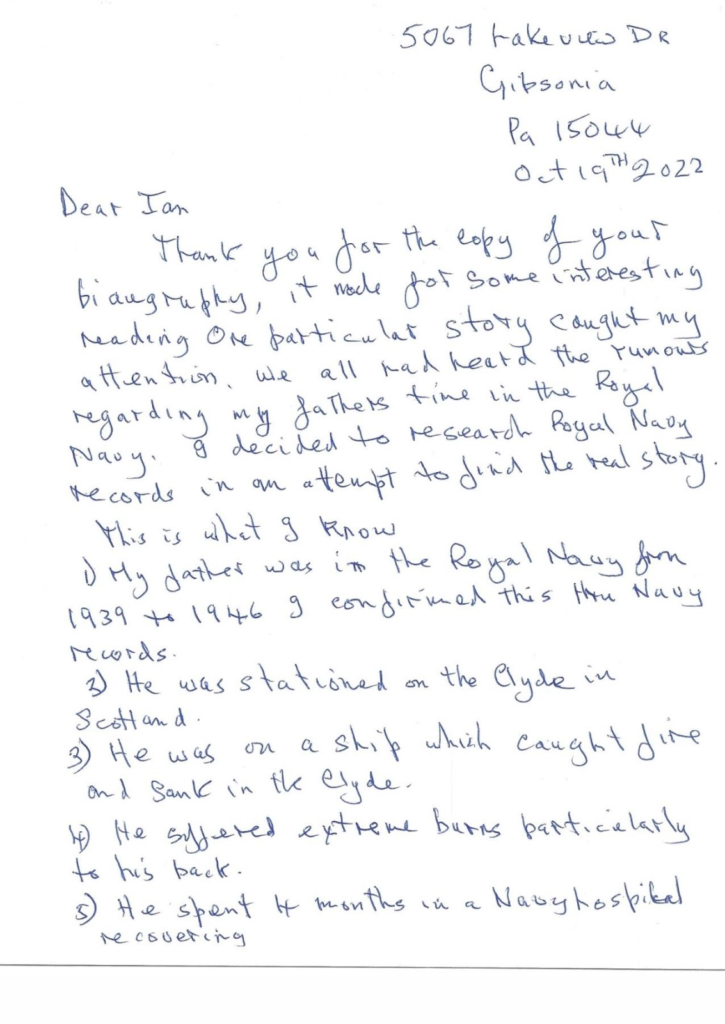
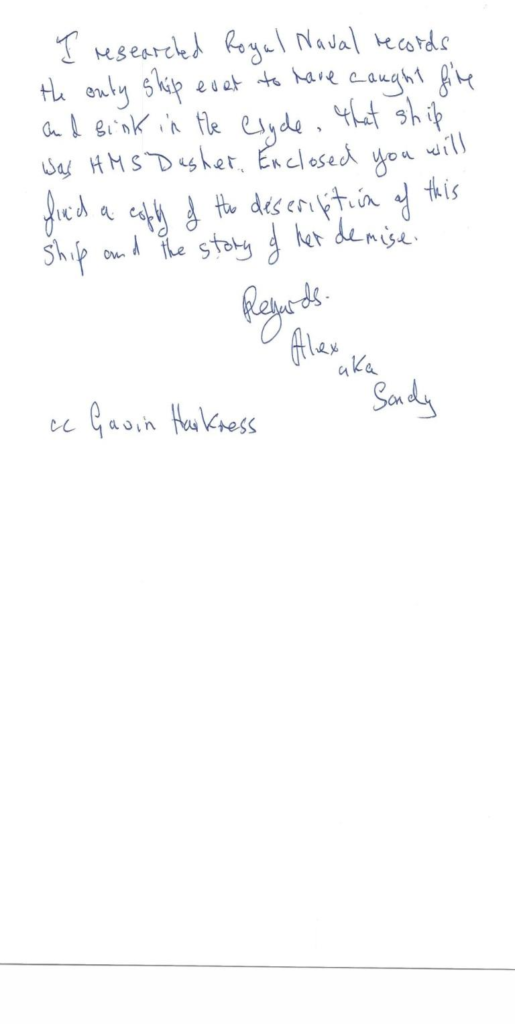
My Comments
On reading the letters between my parents, there is no mention of burns to his back. He wasn’t in a ‘naval hospital’, but a local hospital in Dunoon, Cowal Emergency Hospital.
I doubt that he was in hospital for 4 months. Although the archive of my parents’ letters from this period is incomplete, the letters seem to indicate weeks rather than months.
It seems improbable that he would be on board HMS Dasher, which was an aircraft carrier. Dasher sank in March 1943. My father’s accident occurred in July 1943 (see document included here).
Second Letter
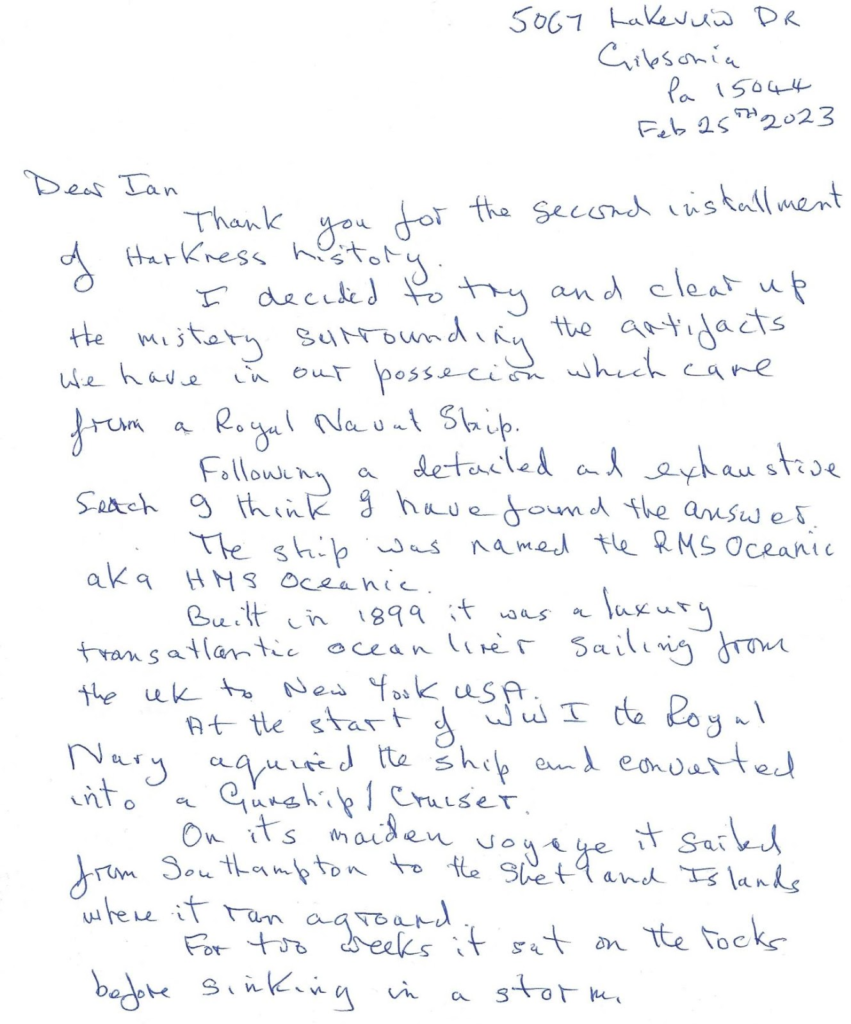
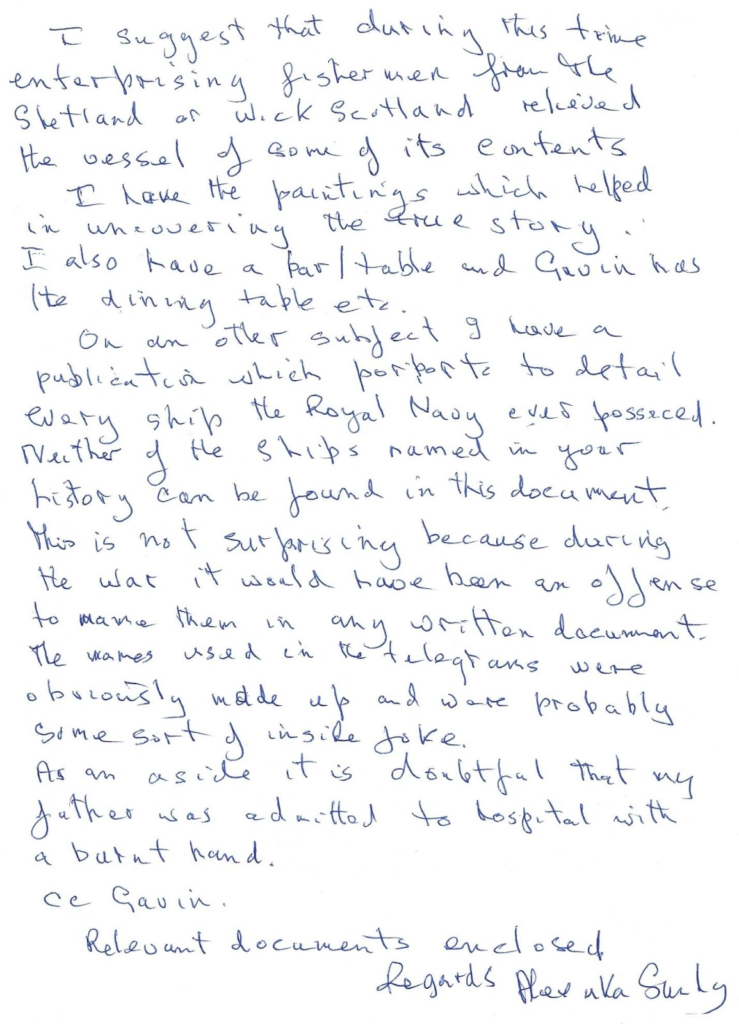
In a second letter, my brother Sandy comments on the identity of two paintings he has in his possession, which he inherited from my mother. These are paintings of the ship, “Oceanic”, which always hung on the walls of our various homes over a long period (ca. 1950-).
The ‘Oceanic” was a popular motif for artists. It was not quite as famous as the “Titanic”, but famous nevertheless. The Oceanic was a product of the Second Industrial Revolution; it was an ‘unsinkable’ ship, which nevertheless sank in the treacherous waters of northern Scotland, more specifically, the Shetland Islands (1914).
Gavin’s, aka Sherlock Holmes
My brother Gavin, has solved the ‘burnt hand conundrum’. That is the episode of how my father burnt his hand during the war, his hospitalization, and the salvaging of a boat’s furniture!
The solution came to light when my brother wrote me an email on 11 May 2023. I will include the email here:

I’ve had this wallet since the clear out at mumsie’s house. It was mouldy and stiff as a board. I cleaned it with saddle soap, enough to open it. I believe this is the wallet he had during the war and these are the two items that I found inside. This now categorically answers the sinking and burning accident. What a bit of luck and a good find. I think carrying a photo of yourself would probably signify that he had just been made up to full lieutenant.
Gavin
 |  |
“At the risk of repeating myself i have been telling you the story of how the old man got injured in every detail apart from the name of the launch. The old man got burnt trying to put the fire out because in effect it was the admirals launch and he would have been shitting bricks. there would almost inevitably have been an enquiry in to what happened as there was with every naval ship that was sunk. As this has never been mentioned in the family folklore i must therefore conclude rightly or wrongly that a more senior officer was also on board who would have accepted the responsibility.”
This seems to make sense. The fact that my father’s burnt hand was because he was trying to put the fire out – and not related to rescuing the boat’s furniture.
My reply to Gavin’s email (May 2023):
Hi Gavin
What an amazing discovery! – the wallet, document, and photo.
This clears up the main ‘puzzle’ of the ‘burnt hand conundrum’, but also opens up queries to new puzzles.
Sinking of Tanmuir
The boat that sank was the “Launch Tanmuir”. The launch was 37 feet in length. As mentioned, I am no ‘boat expert’, but I imagine that such a ‘small’ launch would have little or no furniture. It must have been about the size of a bus, so it could have had some furniture. It sank at 15 fathoms, and is probably still there! So we are perhaps the only people who know of this WWII sunken boat still lying on the ocean bottom! This might be of interest to amateur divers.
After the boat sank, it would have been too deep to salvage anything without specialist diving equipment, which would be too expensive.
It had a 30 hp Thornycroft engine. I’m not sure if this was petrol or diesel. If it was petrol, my father might have burnt his hand while trying to repair the engine. This could explain the inside joke of my father ‘setting fire to his own boat’.
Salvaging the furniture
I could imagine that the launch had a small ‘ship’s chest’ and this is how he burnt his hand and arm (salvaging it). Although, as also mentioned here, he might have been doing a repair to the engine, which resulted in the engine catching fire, and then setting fire to the rest of the boat. It doesn’t take much to set a boat or car on fire if they have petrol engines, due to electrical sparks and the combustible nature of petrol.
I suspect the ‘furniture’ part of the story belongs to another unrelated episode. When my mother was living in her ‘new house’ in Edinburgh, she was almost a caricature of a nest-making mother. In other words, she was concerned with furnishings, curtains, bedspreads, lamps, and so on So I’m sure that if my father’s accident had resulted in him getting some ‘booty’, that is, salvaging furniture from a boat that caught on fire in 1943, then this is something she would obviously have mentioned in her letters – which she didn’t. I suspect some of the furnishings come from Burma.
Chinese whispers
As I have mentioned elsewhere here, oral myths often have a kernel of truth in them, but not all the details of the myth correspond to ‘facts’.
This phenomenon can be related to the ‘Chinese whispers’ or ‘telephone game’:63 Players form a line or circle, and the first player comes up with a message and whispers it to the ear of the second person in the line. The second player repeats the message to the third player, and so on. When the last player is reached, they announce the message they just heard, to the entire group. The first person then compares the original message with the final version. Although the objective is to pass around the message without it becoming garbled along the way, part of the enjoyment is that, regardless, this usually ends up happening.
61 Ma Hla May is John Flory’s Burmese mistress in George Orwell’s novel, “Burmese Days”.
62 Sandy is about one year old or more.
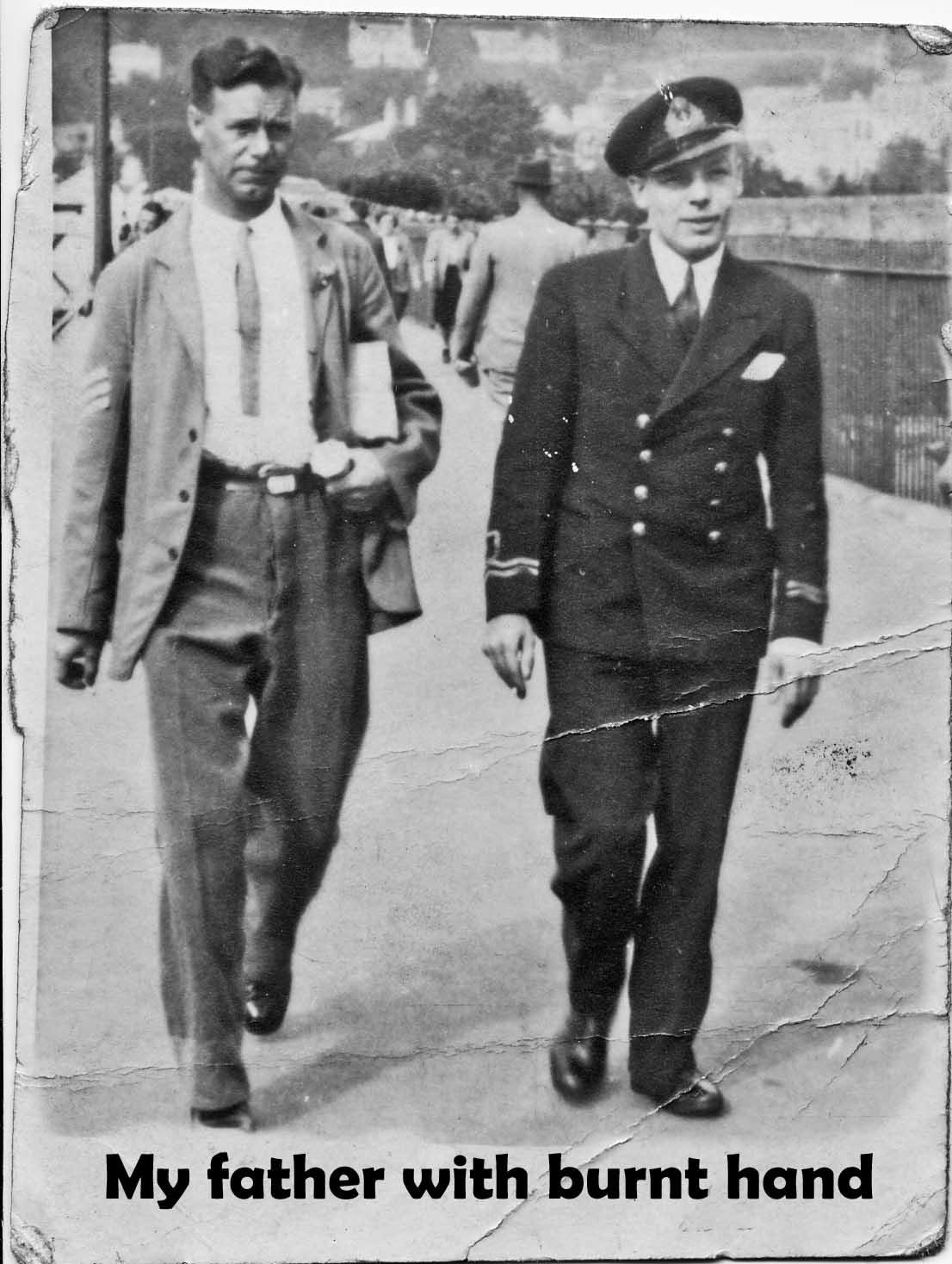
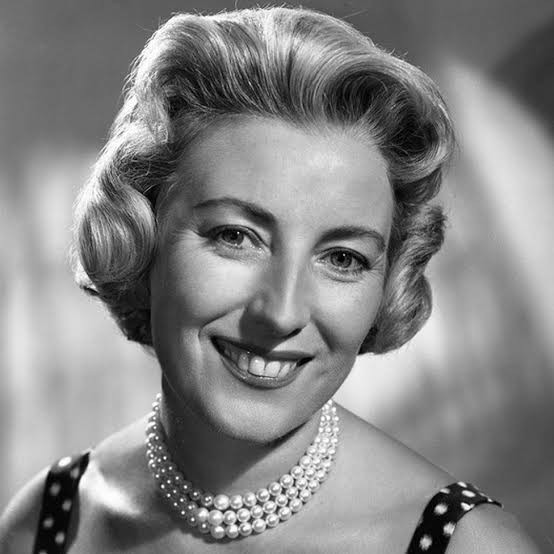

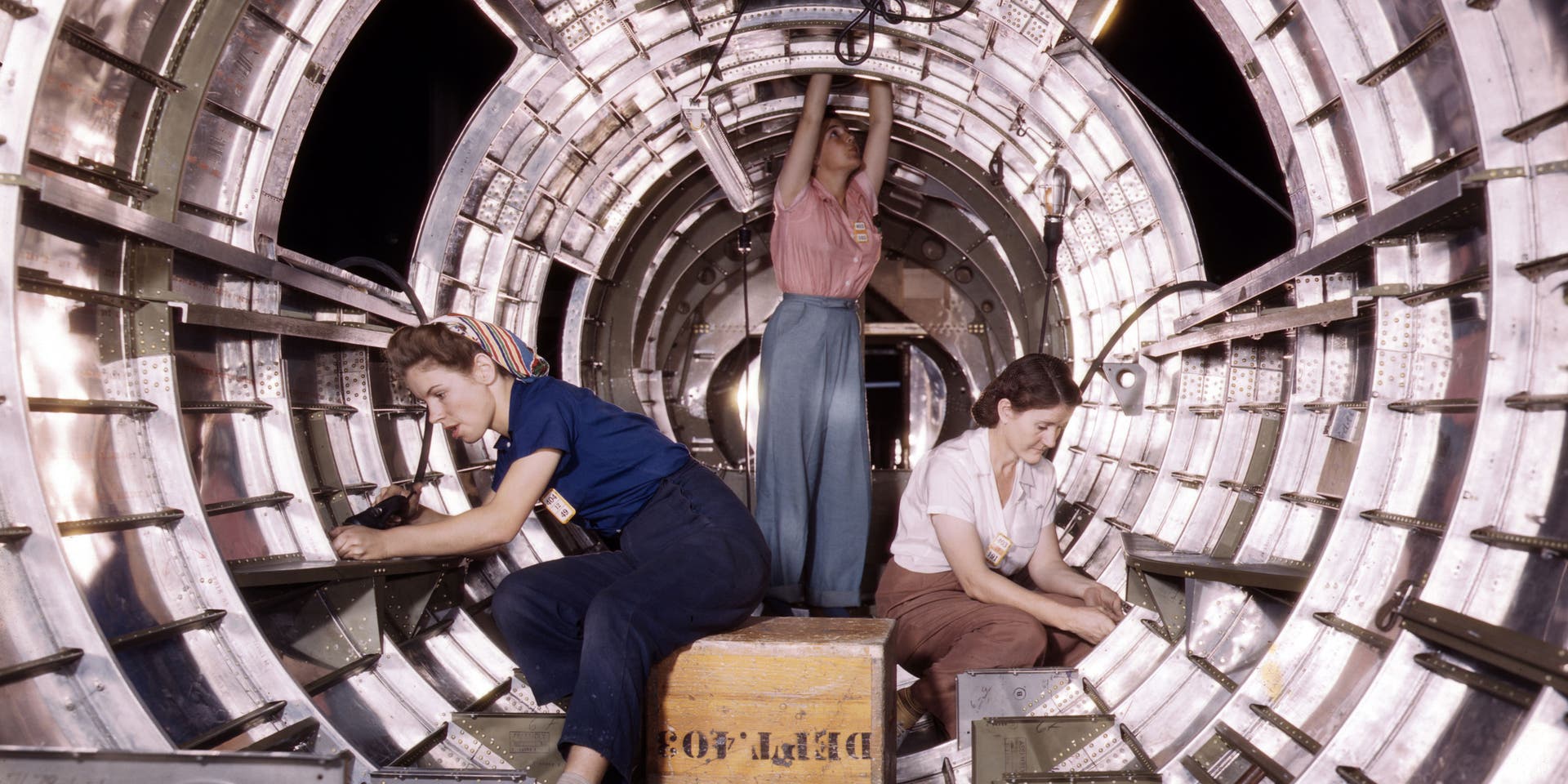
One Reply to “The Burnt Hand and Arm Conundrum”